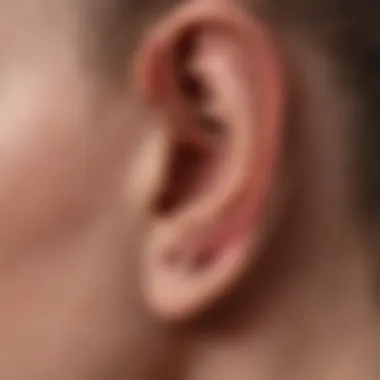Eczema Behind Ears: Understanding a Common Condition


Intro
Eczema is a skin condition that can affect various areas of the body, and one common site for its manifestation is behind the ears. This specific location presents unique challenges in terms of diagnosis and management. Understanding the complexities of eczema behind the ears is crucial for anyone affected by it—whether they are patients, caregivers, or healthcare professionals. This article aims to clarify the nature of this dermatological issue by discussing its causes, symptoms, management strategies, and potential complications.
Research Context
Background Information
Eczema, also known as atopic dermatitis, is a chronic inflammatory skin condition. It often starts in childhood but can occur at any age. The skin behind the ears is particularly susceptible due to its sensitivity and moisture retention. Factors like humidity, allergens, and irritants can exacerbate the condition in this area. The symptoms are often noticeable, leading individuals to seek effective treatment options.
Importance of the Study
Understanding eczema behind the ears holds significant clinical importance because it is frequently overlooked compared to other common areas affected by eczema. By shedding light on this specific condition, healthcare providers can better address it in their patients. Furthermore, increased awareness can lead to improved management techniques which can enhance the quality of life for those affected.
Discussion
Interpretation of Results
Research suggests that eczema behind the ears may be linked to both genetic and environmental factors. For instance, a family history of allergies often correlates with eczema development. Additionally, irritants from daily activities such as hair products and washing habits can further provoke flare-ups. Identifying these triggers is crucial for effective management, as it allows individuals to tailor their treatment accordingly.
Comparison with Previous Research
Previous studies have shown that eczema has various presentations and affected areas. However, much of the literature focuses primarily on more typical areas such as the arms and legs. This lack of attention to the ear area suggests a gap in understanding. Recent investigations emphasize the need for further research into localized eczema forms, including case studies that highlight specific treatment protocols.
Understanding the unique manifestations of eczema behind the ears is essential for effective treatment.
Foreword to Eczema
Understanding eczema is crucial as it affects millions worldwide, presenting challenges in both physical and psychological aspects of daily life. Eczema behind the ears is a localized form of eczema that often goes unnoticed, yet it can lead to significant discomfort and social implications for individuals suffering from this condition. This section aims to lay the groundwork for a more comprehensive discussion by detailing the definitions, types, and characteristics of eczema, particularly emphasizing issues related to areas that are prone to irritation, such as behind the ears.
Eczema is not just a skin condition; it often signifies an underlying immune system response that can be exacerbated by various external factors. By exploring the intricacies of eczema, readers can gain a better understanding of its impact not only on skin appearance but also on one’s quality of life.
Defining Eczema
Eczema, often referenced in medical literature, is a chronic inflammatory skin condition characterized by red, itchy, and swollen skin. Medical professionals define it as an atopic disease, frequently associated with other allergic conditions like asthma and hay fever. While many forms of eczema exist, their underlying principle remains similar—an overactive immune response resulting in skin irritation or inflammation. This becomes particularly relevant when we consider eczema presenting behind the ears, as the area is sensitive and often exposed to a range of irritants.
Types of Eczema
Several forms of eczema can manifest, each with distinct triggers, symptoms, and recommended treatment paths. Understanding these types helps to classify the specific condition affecting an individual while guiding appropriate management strategies.
Atopic Dermatitis
Atopic dermatitis is the most common form of eczema. It is often hereditary and frequently arises in childhood, though it can persist into adulthood. This type is particularly marked by intense itching and dry, inflamed skin. Its contribution to the topic of eczema behind the ears is significant, as it can exacerbate irritation from environmental factors, headwear, or personal care products. The unique feature of atopic dermatitis lies in its association with other atopic diseases and its tendency to cyclically flare, providing a comprehensive understanding of the condition's complexity.
Contact Dermatitis
Contact dermatitis arises when the skin reacts to substances it comes in contact with, be it allergens or irritants. Unlike atopic dermatitis, it is not hereditary but rather a response to external triggers. This type of eczema is essential to mention because it can specifically affect the area behind the ears, especially when individuals use products such as shampoos or earrings that may cause irritation. The primary characteristic is that the inflammation is often localized, making it a specific concern for those treating eczema in this region. Understanding contact dermatitis leads to effective management strategies focused on avoiding known irritants and allergens.
Nummular Eczema
Nummular eczema is distinctive due to its coin-shaped patches on the skin. This type does not have a clear cause but may follow an injury to the skin. In the context of eczema behind the ears, it is valuable to consider its role, as this area can be predisposed to dryness and other irritations. Nummular eczema’s unique feature includes its variability among individuals, making treatment more individualized and sometimes challenging. This type lends itself to a deeper discussion on adaptability in treatment, highlighting the importance of personalized approaches in eczema management.
The Anatomy of Skin Behind the Ears
Understanding the anatomy of skin behind the ears is crucial for recognizing why eczema can develop in this area. The skin is a complex organ that serves multiple functions, including protection, sensation, and regulation of body temperature.
The skin behind the ears is not just a surface layer; it includes various components that interact with external factors. Notably, it has a thinner epidermis compared to other areas, making it more susceptible to conditions like eczema. Additionally, this region has numerous hair follicles and sebaceous glands that may influence skin health. Knowledge of the skin's structure aids in identifying the vulnerabilities that make it a common site for eczema.
Skin Structure Overview
The skin behind the ears consists of three layers: the epidermis, dermis, and subcutaneous tissue. The epidermis is the outer layer, which acts as a barrier against environmental aggressors. Beneath this, the dermis contains blood vessels, nerves, and connective tissues.
- Epidermis: This layer is thinner in areas like behind the ears. It has fewer protective barriers, thus elevating risk.
- Dermis: The deris supports the epidermis and provides nutrients. It can react strongly to irritants and allergens, making it critical in eczema development.
- Subcutaneous Tissue: This innermost layer stores fat and aids in thermoregulation. It plays a role in overall skin health but is not directly involved in eczema.
Adequate understanding of these layers is vital for effective diagnosis and treatment of eczema.
Differences in Skin Characteristics
Skin behind the ears may present unique characteristics. Generally, the skin in this area is:
- Thinner: As mentioned, thin epidermis can increase vulnerability to eczema. This means any irritation can lead to a skin reaction.
- Oily or Dry: Depending on individual skin types and humidity factors, the area can exhibit dryness or excessive oiliness. Both states can predispose the skin to eczema flare-ups.
- Higher Sensitivity: The skin behind the ears is more sensitive to products such as shampoos and skincare items which might contain allergens.
Recognizing these differences is essential for developing tailored treatment strategies for eczema.
Proper understanding of skin specifics helps in choosing appropriate treatments, whether topical or systemic.
Causes of Eczema Behind the Ears
Understanding the causes of eczema behind the ears is crucial for effective management and prevention. This section addresses the complex interplay of factors that can aggravate or trigger eczema in this sensitive area. Identifying these factors can not only facilitate better treatment regimens but also help individuals avoid triggers and maintain skin health. By recognizing the underlying causes, patients and caregivers can approach eczema with a more informed mindset.
Genetic Factors
Genetic factors play a significant role in the development of eczema, including cases behind the ears. Individuals with a family history of eczema or other atopic conditions, such as asthma or hay fever, are more susceptible. This correlation suggests a hereditary component that influences the immune responsiveness.
Understanding one's genetic predisposition can guide preventative measures and treatment. For those at risk, regular skin care and the use of emollients can help mitigate the likelihood of flare-ups.
Environmental Triggers
Environmental triggers encompass a range of factors that can exacerbate eczema. Among these, allergens, irritants, and climate conditions are particularly noteworthy.
Allergens
Allergens such as pollen, dust mites, and pet dander can provoke an immune response that leads to eczema flare-ups. Exposure to these substances is often unavoidable, but awareness can help in minimizing contact.


The key characteristic of allergens is their ability to activate the body's immune system. This reaction can result in inflammation and skin irritation, which are central to eczema. Understanding the specific allergens to which an individual is susceptible is beneficial for targeted avoidance strategies, ultimately contributing to better skin health and reduced symptoms.
Irritants
Irritants include everyday substances that can damage the skin barrier, such as soaps, detergents, and fragrances. Their role in eczema is significant because they can weaken the skin's natural defenses and lead to increased sensitivity.
The major feature of irritants is their potential to trigger immediate reactions upon contact. Unlike allergens, which may cause delayed responses, irritants can result in instant skin irritation. Awareness of personal sensitivities is vital for avoiding irritants and minimizing exposure, helping individuals manage eczema more effectively.
Climate
Climate can considerably influence eczema symptoms behind the ears. Hot, humid conditions can cause sweating, while cold, dry air might lead to skin moisture loss. Both scenarios present unique challenges that can exacerbate eczema.
The key aspect of climate is its variability. Seasonal changes often bring different triggers for eczema, necessitating adaptable coping mechanisms. For example, using humidifiers in dry months or lightweight clothing in warmer seasons may alleviate symptoms.
Underlying Health Conditions
Underlying health conditions can complicate eczema, particularly when it affects areas like behind the ears. Conditions such as allergies, infections, or dermatitis may exacerbate the severity of eczema. Recognizing these underlying issues is imperative for holistic management. Treatment often requires addressing both the eczema itself and any concurrent health issues.
Symptoms of Eczema Behind the Ears
Understanding the symptoms of eczema behind the ears is critical for prompt recognition and effective management. This region can experience unique manifestations due to its specific anatomical characteristics, such as increased moisture and skin friction. The symptoms can lead to discomfort and may significantly affect a person’s daily life. Recognizing these symptoms enables individuals to seek timely treatment and implement effective self-care strategies.
Common Symptoms
Eczema behind the ears often presents with a variety of typical symptoms. The most prevalent ones include:
- Redness and Inflammation: The skin in the affected area may appear red and swollen. This reflects underlying irritation and should not be overlooked.
- Itchiness: A persistent itching sensation can be bothersome. Scratching may induce additional inflammation and worsen the condition.
- Dryness and Scaling: The skin may become excessively dry, leading to flakes or scales. This can contribute to the appearance of the affected area.
- Crusting or Oozing: In more severe cases, the eczema can lead to crusty patches or weeping sores. This often indicates a breach in the skin barrier and potential infection.
While these symptoms are common, their intensity may vary from person to person. Individuals experiencing these symptoms should pay close attention to changes in appearance or sensation.
Distinguishing Features
Identifying distinguishing features of eczema behind the ears can aid in differentiation from other skin conditions, such as psoriasis or dermatitis. Key features that help to differentiate eczema include:
- Location: Eczema is particularly notable for appearing behind the ears, while other conditions may not affect this area specifically.
- Fluid-filled Blisters: In some instances, eczema can produce small blisters filled with fluid. This characteristic is different compared to other skin conditions that may present differently.
- Relapsing Nature: Eczema often features cycles of flare-ups and remissions. People may notice that symptoms can return following periods of improvement.
Timely recognition of symptoms is essential. Understanding the characteristics of eczema can help prevent complications and improve quality of life for those affected.
By being aware of these distinguishing features, individuals can better communicate their concerns with healthcare providers, facilitating a more effective diagnostic process and treatment plan.
Diagnosis of Eczema Behind the Ears
Diagnosis of eczema behind the ears is a pivotal aspect of managing this skin condition effectively. Understanding the diagnostic process helps patients and healthcare providers differentiate eczema from other skin issues that might appear similar. By identifying the specific type of eczema, appropriate treatment can be implemented, which is crucial in preventing complications and improving the patient's quality of life.
Diagnosis often begins with a detailed history and thorough examination of the affected area. This context is vital, as eczema is multifaceted; different patients may present varying symptoms. The right diagnosis enables targeted management strategies that cater to individual needs.
Physical Examination
The physical examination is the cornerstone of eczema diagnosis. During this step, dermatologists assess the appearance of the skin behind the ears and surrounding areas. They usually look for common indicators of eczema, such as redness, swelling, and scales. The intensity and distribution of these signs can provide clues.
The dermatologist may also note the presence of secondary infections or other conditions that often accompany eczema. It is important to analyze the skin's texture and observe any signs of itching. The patient’s medical history, including previous episodes and potential triggers, also plays a crucial role in this examination.
Moreover, detailed documentation of the condition's progression helps in understanding how it responds to various treatments or environmental factors. This step not only aids the practitioner in formulating a treatment plan but also supports the patient in comprehending their condition.
Allergy Testing
In addition to the physical examination, allergy testing is often recommended to identify specific allergens that may trigger eczema flares. This testing can be essential for patients whose eczema does not respond to conventional treatments.
Allergy testing typically involves skin prick tests or blood tests. These methods measure the skin's reaction to various substances, such as pollen, animal dander, or certain foods. Understanding these allergens helps to avoid environmental triggers, which may lead to dermatitis flares.
In cases where allergens are identified, the healthcare provider can offer strategies to limit exposure. Moreover, addressing the underlying allergic reactions can significantly reduce the severity and frequency of eczema outbreaks behind the ears.
An accurate diagnosis through effective physical examination and allergy testing lays the groundwork for successful eczema management, emphasizing the importance of proactive healthcare intervention.
Treatment Options for Eczema Behind the Ears
When managing eczema behind the ears, treatment options play a crucial role. This area is particularly sensitive, making targeted treatment essential. Individuals often seek effective solutions that reduce inflammation, alleviate discomfort, and prevent flare-ups. Appropriate treatment options can enhance the quality of life for those affected, reducing both physical symptoms and psychological burden.
Topical Treatments
The topical treatments focus on applying medications directly on the skin. They work by targeting the areas that are inflamed or irritated. These treatments are commonly used due to their localized effect.
Corticosteroids
Corticosteroids are anti-inflammatory medications commonly prescribed for eczema. Their primary function is to reduce inflammation and ease itching, which are significant symptoms of eczema. Corticosteroids come in various strengths, allowing for flexibility in treatment.
Key Characteristic: Corticosteroids can quickly diminish redness and swelling.
Benefits: They are popular because they are effective in acute flares. Patients often find immediate relief through these medications.
Unique Feature: However, prolonged use can thin the skin, particularly in delicate areas like behind the ears. This risk requires careful management and occasional breaks in treatment.
Moisturizers
Moisturizers are critical in managing eczema. Their main goal is to hydrate the skin and restore the skin barrier. This is particularly important for eczema sufferers, as dryness can exacerbate symptoms.
Key Characteristic: Regular use of moisturizers can significantly improve skin texture over time.
Benefits: They are beneficial for daily care, helping to prevent flare-ups before they occur. This proactive approach often results in fewer serious outbreaks.
Unique Feature: While moisturizers are generally safe, choosing the right formulation is essential. Fragrance-free and hypoallergenic products are recommended to avoid irritation.
Calcineurin Inhibitors


Calcineurin inhibitors, including tacrolimus and pimecrolimus, are non-steroidal options for treating eczema. These medications work by modulating the immune response, thereby reducing inflammation.
Key Characteristic: They are particularly useful for sensitive areas like behind the ears.
Benefits: Unlike corticosteroids, they do not carry the same risk of skin thinning, making them a safer long-term option.
Unique Feature: However, some patients may experience stinging or burning upon application, but these sensations typically resolve quickly.
Systemic Treatments
When topical treatments do not provide sufficient relief, systemic treatments may be necessary. These involve oral medications or injections targeting eczema from within.
Oral Medications
Oral medications, such as antihistamines and immunosuppressants, serve to control allergic reactions and reduce overall inflammation.
Key Characteristic: They offer a broader approach compared to topical options.
Benefits: Oral medications can help manage severe conditions efficiently, providing relief to those with extensive eczema.
Unique Feature: However, they may have side effects such as sedation or increased risk of infection, which need consideration.
Biologics
Biologics represent a newer class of medications targeting specific pathways in immune response. They show promise for individuals with moderate to severe eczema.
Key Characteristic: These treatments are typically administered via injection or infusion.
Benefits: They can lead to significant improvements in skin health and quality of life for those who respond well to them.
Unique Feature: Biologics might not be suitable for everyone and often come at a higher cost compared to traditional treatments.
Alternative Therapies
Alternative therapies can complement traditional treatments and provide additional relief.
Phototherapy
Phototherapy utilizes controlled exposure to ultraviolet light. This treatment can effectively reduce inflammation and itching.
Key Characteristic: It helps in modifying the immune response that contributes to eczema.
Benefits: Patients often find it beneficial for localized areas like the skin behind the ears.
Unique Feature: While it can be effective, phototherapy requires repeated sessions, and the risks of skin damage must be monitored.
Natural Remedies
Natural remedies, including coconut oil and aloe vera, are often sought for their soothing properties. They serve as adjunct treatments for many patients.
Key Characteristic: Many prefer natural options for their lack of side effects compared to conventional treatments.
Benefits: These remedies can provide moisturizing benefits and aid in healing without the harsh chemicals.
Unique Feature: It is important to remember that not all natural remedies are effective for everyone, and some could cause irritation.
Preventing Eczema Behind the Ears
Understanding how to prevent eczema behind the ears is crucial for those experiencing this condition. Prevention can significantly reduce flare-ups and the severity of symptoms, leading to an improved quality of life. By adopting effective personal hygiene practices and avoiding known triggers, individuals can better manage their eczema. This section will explore practical strategies to minimize the risk of developing eczema or exacerbating existing symptoms.
Personal Hygiene Practices
Maintaining proper hygiene is vital in prevention efforts. The skin behind the ears requires special attention due to its unique characteristics. Here are some essential practices that can help:
- Regular Cleaning: Gently wash the area behind the ears with a mild, fragrance-free cleanser. This helps remove dirt and sweat that can irritate the skin.
- Drying Thoroughly: After washing, ensure the area is thoroughly dried. Moisture can contribute to eczema flare-ups. Use a clean towel to pat the area instead of rubbing it, which may cause irritation.
- Regular Inspection: Check the skin behind your ears regularly for any signs of irritation or rash. Early detection can aid in better management before the condition worsens.
- Use of Moisturizers: After cleansing, apply a fragrance-free moisturizer to keep the skin hydrated. An adequate moisture barrier can prevent dryness.
Implementing these practices helps create a healthy environment for the skin, reducing the likelihood of eczema episodes.
Avoiding Known Triggers
Identifying and avoiding specific environmental triggers is key to preventing eczema. Common triggers include:
- Allergens: Pollen, dust mites, and pet dander can provoke an immune response that worsens eczema. Regular cleaning of living spaces can decrease these allergens.
- Irritants: Fragrances in soaps and lotions can irritate sensitive skin. Opt for products labeled as hypoallergenic.
- Climate: Extreme temperatures, whether hot or cold, can impact skin health. Consider wearing a hat or scarf in cold weather to protect the skin.
- Sweating: Excessive sweating may aggravate the condition. Dress in loose, breathable fabrics to help manage moisture levels.
By taking a proactive approach to identify and avoid these known triggers, individuals can significantly decrease their chances of experiencing eczema behind the ears.
Preventive measures can make a substantial difference in managing eczema. Small changes in habits often lead to significant outcomes.
Complications Associated with Eczema Behind the Ears
Eczema can lead to a variety of complications, particularly when it affects sensitive areas like behind the ears. This section emphasizes the significance of understanding these complications as part of a comprehensive management plan.
Individuals with eczema behind the ears may experience skin infections, which occur when the skin barrier is compromised. The broken skin can become a pathway for bacteria and fungi to invade. This risk increases with scratching, common among those suffering from the itchiness associated with eczema. Such infections may present as redness, swelling, and pus. It’s crucial for patients to recognize these signs early to seek appropriate treatment, preventing more severe health issues.
Another significant consideration is the impact on quality of life. Eczema can be more than just a physical ailment; it can affect emotional and social well-being. Individuals may feel self-conscious about visible rashes behind their ears. This can lead to anxiety and a sense of isolation, particularly in social or professional settings. Understanding these effects is essential for both patients and caregivers. Addressing these issues can enhance overall care strategies, ensuring both the physical and emotional aspects of eczema are managed effectively.
"Awareness of potential complications can empower individuals to take proactive steps in managing their condition, ultimately leading to improved health outcomes."
Skin Infections
Skin infections are a common complication associated with eczema, especially in the area behind the ears. Due to constant scratching or irritation, the skin can break down, allowing pathogens to enter.
Types of infections that may occur include:


- Bacterial infections: Often manifest as red, swollen, and sometimes oozing areas. They require medical treatment, usually antibiotics.
- Fungal infections: These can arise in moist areas typically affected by eczema. They may cause additional discomfort and require antifungal treatments.
Attention to hygiene is essential. Regularly cleaning the affected area can help prevent infection.
Impact on Quality of Life
The effects of eczema on quality of life can be profound. The itchiness and discomfort often lead to sleep disturbances, impacting daily activities. Furthermore, repeated flare-ups can cause considerable frustration and stress.
Key areas impacted include:
- Social interactions: Visible symptoms may make individuals reluctant to engage socially. This can lead to withdrawal and feelings of loneliness.
- Emotional well-being: The chronic nature of eczema can contribute to anxiety and depression. Patients may benefit from support groups or counseling to address these feelings.
In summary, complications associated with eczema behind the ears are not merely physical; they can lead to significant emotional distress. Understanding these challenges is vital for effective management and improving the overall quality of life for individuals affected by eczema.
When to Seek Medical Advice
Recognizing when to seek medical advice is crucial for individuals experiencing eczema behind the ears. This condition can lead to various skin issues, and timely intervention may prevent complications. Understanding the right moment to consult a healthcare professional can significantly improve management and treatment outcomes.
Warning Signs
Certain indicators suggest the need for prompt medical attention. It is important to remain vigilant about changes in the condition. Key warning signs include:
- Severe Itching: If itching becomes intense and persistent, it may indicate worsening eczema.
- Increased Redness or Swelling: Noticeable changes in skin appearance, such as increased redness or swelling, may signal an infection or aggravation.
- Oozing or Crusting: If the affected area starts to ooze fluid or form crusts, this could suggest a secondary bacterial infection.
- Fever: An elevated temperature can accompany skin infections, marking a need for immediate evaluation.
- Lack of Improvement: If there is no noticeable improvement despite home treatment, it is wise to consult a healthcare provider.
These warning signs denote a shift in the condition's severity and warrant medical expertise to avoid further complications.
Consulting a Dermatologist
Consulting a dermatologist can be a crucial step in managing eczema effectively. Dermatologists specialize in skin disorders and can provide tailored treatment options. Factors to consider when seeing a dermatologist include:
- Expert Assessment: A dermatologist can assess the severity of eczema and its specific characteristics behind the ears, leading to an accurate diagnosis.
- Customized Treatment Plans: They can design a treatment strategy based on individual needs, potentially incorporating both topical and systemic treatments.
- Monitoring and Follow-Up: Regular consultations can help in monitoring the condition’s progress, allowing adjustments to treatment as required.
- Understanding Triggers: Specialists can also assist in identifying personal triggers and suggest lifestyle changes or preventive measures.
Seeking advice from a dermatologist ensures that individuals receive comprehensive care tailored to their unique situations. It is essential for an effective long-term management strategy, especially for chronic cases of eczema.
Consulting a healthcare professional promptly is key to preventing complications associated with eczema behind the ears.
Living with Eczema Behind the Ears
Managing eczema behind the ears requires a comprehensive approach that goes beyond treatments alone. Understanding how this condition impacts daily life is essential for anyone dealing with eczema in this sensitive area. The skin behind the ears is particularly vulnerable due to its delicate nature. This can lead to discomfort, itching, and potential skin infections if not properly cared for. Therefore, delving into the daily realities of living with eczema helps illuminate the importance of consistent self-care and lifestyle adjustments.
Mental Health Considerations
Eczema is not just a physical condition; it can significantly affect an individual’s mental well-being. The visibility and discomfort of eczema behind the ears can lead to feelings of self-consciousness, anxiety, and even depression. For many, the condition can interfere with social interactions. Simple activities, such as going out with friends or attending work events, may feel daunting. It is crucial to recognize these mental health aspects when managing eczema.
Some strategies to address these mental impacts include:
- Open Communication: Discuss feelings with trusted friends or family members. Sharing experiences can help validate emotions and reduce feelings of isolation.
- Support Groups: Engaging with online forums or local support groups allows individuals to connect with others who understand their struggles. This can enhance emotional support and provide practical tips.
- Mindfulness Practices: Techniques such as meditation or yoga can help manage stress, which may exacerbate eczema symptoms.
Overall, addressing one's mental health is an integral part of living well with eczema.
Support and Resources
Finding the right support and resources is vital for those affected by eczema behind the ears. Knowledge and assistance can empower individuals to find suitable management strategies. Key resources include:
- Dermatologist Consultation: Regular check-ups with a dermatologist can help tailor treatment plans. Experts can suggest effective topical solutions and dietary recommendations.
- Educational Websites: Websites like Wikipedia, Britannica, and others provide valuable information on the condition, its management, and patient stories.
- Social Media Groups: Platforms like Facebook and Reddit host various communities where individuals share experiences and solutions. These forums can be a source of motivation and practical advice.
In summary, understanding the impact of eczema on mental health and making use of available resources can greatly enhance the experience of living with eczema. Building a support system is key to managing both the physical and emotional aspects of this condition.
Research Insights on Eczema
Understanding eczema, particularly behind the ears, demands thorough research. Recent studies illuminate the complexities of this condition and enhance treatment protocols. The investigation extends beyond symptoms and treatments, exploring genetics and environmental factors. It brings forward knowledge that supports healthcare professionals and patients alike in managing eczema effectively. Insights help identify trends, assess risk factors, and monitor treatment efficacy. With a foundation of evidence, resource allocation for research can improve outcomes for individuals affected by this condition.
Recent Studies and Findings
New studies have emerged, highlighting several key aspects of eczema behind the ears:
- Genetic Disposition: Current research focuses on the role of genetics. It reveals specific genes correlate with atopic dermatitis, which includes eczema. Understanding these can lead to targeted therapies.
- Inflammation Response: Investigations into the immune response are proving critical. Studies indicate that inflammation around the ears is linked to triggers like allergens and irritants.
- Microbiome Influence: The skin microbiome is essential. Recent studies illustrate the importance of microbial diversity in skin health. A varied microbiome may help mitigate severe eczema outbreaks.
"The connection between skin microbiome and eczema severity offers exciting avenues for prevention and treatment."
- Environmental Impact: Researchers also explore how varying environmental conditions impact eczema. Findings show that climate can exacerbate or ease symptoms for patients.
These studies contribute towards a deeper understanding of eczema's nature. They reveal how genetic and environmental factors work together, offering a wealth of information to healthcare providers.
Future Research Directions
Future inquiries into eczema behind the ears should prioritize the following areas:
- Longitudinal Studies: Extended studies tracking individuals over time could yield insights into eczema's progression and the effectiveness of various treatments.
- Personalized Medicine: Understanding genetic factors opens doors for personalized treatment approaches. More exploration into tailored therapies could improve patient outcomes significantly.
- Impact of Diet: Linking diet with eczema symptoms warrants investigation. Future studies should dissect dietary impacts on inflammation and skin health.
- Innovative Therapies: Research should promote the development of novel therapies, such as new biologics or targeted immunotherapies that can provide relief with fewer side effects.
By exploring these directions, research can lead to breakthroughs in understanding and managing eczema behind the ears, ultimately benefiting those affected. The commitment to researching eczema in diverse contexts remains crucial as it shapes practical guidelines for treatment.
Epilogue
Understanding eczema, particularly when it manifests behind the ears, is essential for effective management and prevention. This condition can significantly impact an individual's quality of life due to discomfort and social stigma associated with visible skin issues. Addressing the concerns linked to eczema requires both awareness and tailored treatments. In this context, recognizing the symptoms and triggers plays a crucial role for individuals and healthcare professionals alike. When a patient can identify their unique triggers, it often leads to better management and reduced flare-ups.
Strategies for treatment are vital. They encompass a variety of options from topical applications to systemic medications. It is important to remember that eczema is often a chronic condition that may require ongoing management. Hence, exploring alternatives like natural remedies and phototherapy can offer additional strategies for some individuals. Furthermore, maintaining good skin care practices can prevent exacerbations, making daily routines more bearable.
Ultimately, seeking timely medical intervention can prevent complications such as skin infections or severe flare-ups. A dermatologist can provide insights and treatments tailored to individual needs. Through education, advocacy, and sharing experiences, we can facilitate a more informed discourse around eczema. This collective understanding contributes not only to personal health management but also engenders community support and empathy.
Summary of Key Points
- Eczema behind the ears can lead to significant discomfort and alter quality of life.
- Identifying individual triggers is essential for effective management.
- Treatment options are varied, ranging from topical to systemic interventions.
- Ongoing education empowers individuals to navigate their condition effectively.
- Seeking professional help is critical to avoid complications.
Final Thoughts on Eczema Management
Proper management of eczema requires a multifaceted approach. It’s not limited to medical treatment; lifestyle changes and preventive measures are equally important. Patient education stands at the forefront of effective management strategies. Through understanding their condition, individuals can better engage with healthcare professionals to create effective treatment plans.
Additionally, self-care practices, such as using appropriate moisturizers and identifying irritants in personal care products, can vastly improve skin health. As research on eczema continues to evolve, staying informed about the latest findings can provide new avenues for effective management.















